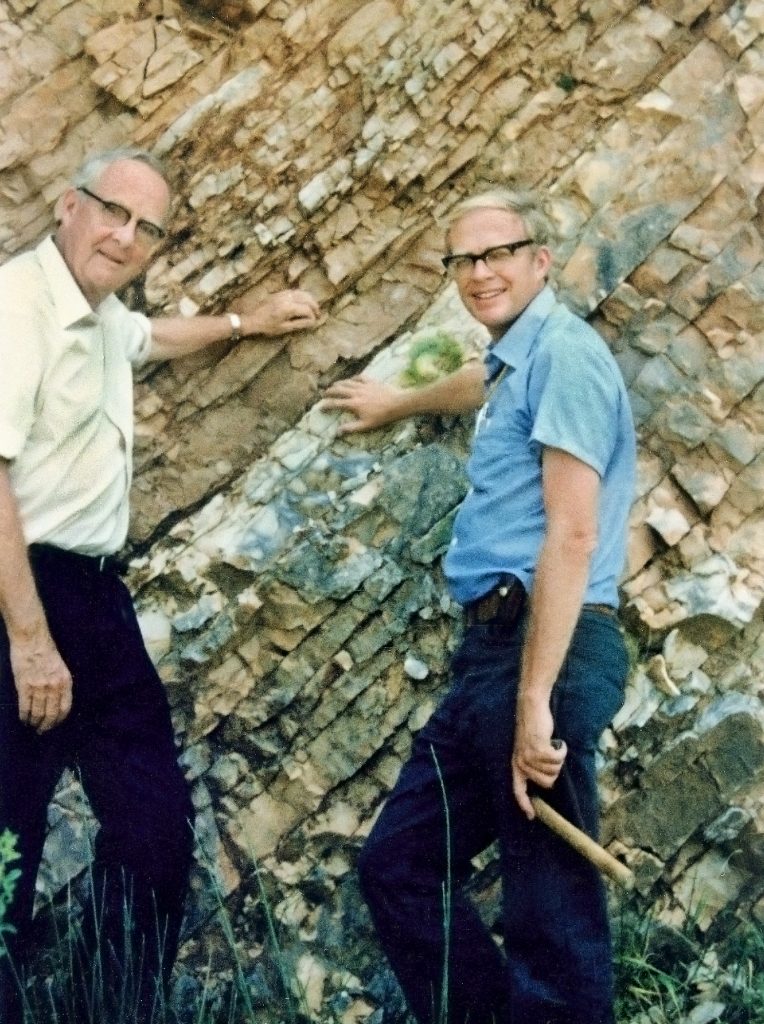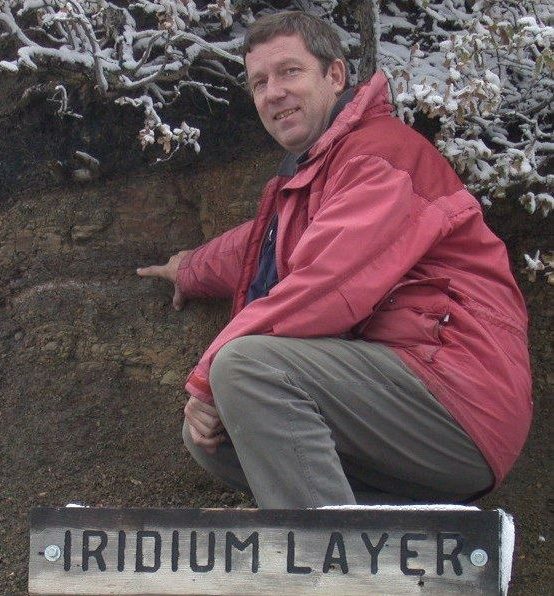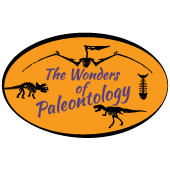By Cindi Sirois Collins

The Alvarez Asteroid Hypothesis
Dr. Walter Alvarez (right), a geologist, and his father, Dr. Luis Alvarez (left), a Nobel Prize- winning physicist, both from the University of California-Berkeley were in Gubbio, Italy on a geology expedition in 1981. Upon examining some limestone strata (layers), the young doctor identified with his hand the bottom limestone layer pictured above as the Cretaceous Period. The older Dr. Alvarez is touching the Paleogene layer. In geology the bottom layer is older as it was deposited first.
Between these two layers is about a half-inch (I cm) layer of clay. It was the young Dr. Alvarez’s idea to figure out how long it took this one layer to be deposited by looking at the amount of iridium and other elements from outer space that penetrated that layer.
Iridium, a rare Earth element, occurs naturally only in the Earth’s core. It is found in scant amounts on the surface from impacts of debris from space like meteorites. It is measured in parts per billion (ppb).
Dr. Walter Alvarez expected the results of his clay layer sample to be less than 1 ppb of iridium but got about 80 ppb instead! How could this much iridium occur in one layer? The only conclusion would be an extraterrestrial meteorite or asteroid of great size that entered the Earth’s atmosphere and created an impact. If so, then where was its enormous crater?
Finding the Crater- Proof of the Hypothesis
It took about 10 years of scientific study of the stratigraphy, magnetism, and iridium amounts in the rock to finally find the Chicxulub crater underwater in the Yucatan Peninsula of Mexico. The crater was first discovered by Antonio Camargo and Glen Penfield, who were petroleum geophysicists in the Yucatán Peninsula during the late 1970s. Through magnetic and gravity field inconsistencies, a research team of 7 scientists from geology and the petroleum drilling industry, later found this to be the crater of the enormous asteroid that killed the dinosaurs.(Hildebrand, et al., 1991).
This team found a 90-meter thick ejectadeposit around Haiti and Mexico that indicated a large impact had taken place possibly at the end of the Cretaceous to the beginning of Paleogene (Tertiary) Periods.
An Unfortunate Event Leads to Many Distinctive Discoveries for Dr. Jan Smit

Dr. Jan Smit, a Dutch geologist, discovered the same clay layer in Tunisia at the same time as the Alvarez discovery. He sent his layer sample in to be analyzed and was told it had been “contaminated” (which turned out to be too much iridium)- so his discovery of the same clay layer did not get published and credit was not given to him at the same time as the Alvarez hypothesis.
Thirty years later, Dr. Jan Smit got his due diligence for his part in the Cretaceous-Paleogene boundary layer discovery when he was taken along on the International Ocean Drilling Program’s Expedition 364 in 2016 as one of the scientists to analyze the peak rings of the Chicxulub crater. From this he was able to glean evidence of possible ways that the environment lead to the extinction of the dinosaurs. This research has literally taken this hypothesis to the theory level.
Dr. Smit was also part of the professional paper, DePalma, et al., in 2019 that found ejecta spherules (tiny glass balls) of this impact in the gills of sturgeon-like fish. There was so much of this debris in the atmosphere that it was falling in rivers and lakes in North Dakota, Montana and around the world. This was evidence of the incredible distances the tsunamis covered during this tumultuous time 66 million years ago.

It’s an enjoyable video with great concepts and teaching resources as well! See below!
Hey Teachers and Homeschoolers:
https://www.biointeractive.org/classroom-resources/day-mesozoic-died
Here is a made by NASA’s Goddard Space Center about the multitude of findings on the day the extinction event occurred. The presentation lasts an hour with questions by leading scientists afterward. Enjoyable for those serious paleo people.
Tanis – The Final Day of the Cretaceous by Dr. Robert DePalma
